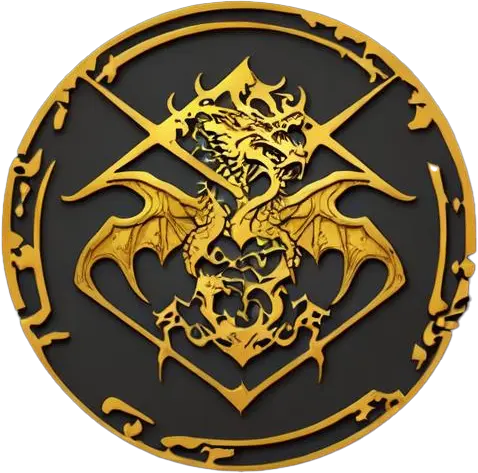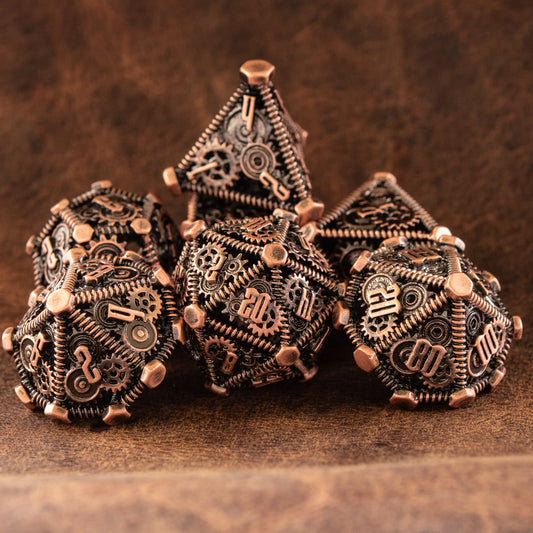Understanding Dice in Dungeons & Dragons (D&D)
Share
Understanding Dice in Dungeons & Dragons (D&D)
Introduction
In the world of Dungeons & Dragons (D&D), dice are more than just tools for generating random numbers—they're the very heartbeat of the game. They determine the fate of characters, the outcomes of battles, and the success of daring adventures. Whether you're a seasoned adventurer or a newcomer to the realms of fantasy, understanding the different types of dice and their roles is crucial. Let's delve into the fascinating world of D&D dice and discover why they are indispensable to the game.
Section 1: Understanding D&D Dice
Subsection 1.1: What Are Polyhedral Dice?
Polyhedral dice, as the name suggests, are dice with multiple faces. Unlike the common six-sided dice (d6) found in traditional board games, polyhedral dice come in various shapes and sizes, each serving a unique purpose in D&D. These dice are integral to the game, adding an element of chance and excitement to every roll. From determining the success of a stealth check to calculating the damage of a fireball spell, polyhedral dice are the arbiters of fate in D&D.
Subsection 1.2: The Standard D&D Dice Set
A standard D&D dice set includes seven different dice, each with a distinct number of sides:
- d4 (Four-Sided Die): Shaped like a pyramid, the d4 is often used for minimal damage or small bonuses.
- d6 (Six-Sided Die): Familiar from traditional games, the d6 is used for weapon damage and determining hit points.
- d8 (Eight-Sided Die): The d8 is commonly used for weapon and spell damage.
- d10 (Ten-Sided Die): Used for percentile rolls and determining critical hits and skill checks.
- d12 (Twelve-Sided Die): This die is used for heavy weapon damage and powerful spells.
- d20 (Twenty-Sided Die): The most iconic die in D&D, the d20 is used to determine the success or failure of actions.
- Percentile Die (d%): Paired with a d10, the percentile die is used to create a range from 1 to 100.
Subsection 1.3: Why Different Dice Are Needed
Different types of dice are essential in D&D because they serve various functions and add depth to the gameplay. For instance:
- d4: Used for minor damage and bonuses, such as the damage dealt by a dagger or the healing from a small potion.
- d6: Commonly used for calculating damage from weapons like swords and for determining character hit points.
- d8: Often used for spells and abilities that deal moderate damage.
- d10: Crucial for percentile rolls and determining the severity of certain effects.
- d12: Used for powerful attacks and spells that deal significant damage.
- d20: The primary die for checks, saving throws, and attack rolls, making it the most frequently used die in the game.
- Percentile Die: Used for generating numbers between 1 and 100, often for determining loot or the success of complex actions.
Section 2: Detailed Breakdown of Each Die
Subsection 2.1: d4 (Four-Sided Die)
The d4, resembling a small pyramid, is used for minimal damage and small bonuses. It is commonly rolled for attacks with light weapons like daggers or for spells that deal low damage. Despite its small size, the d4 plays a critical role in various game mechanics.
Subsection 2.2: d6 (Six-Sided Die)
The d6 is perhaps the most familiar die to players, as it is widely used in many traditional games. In D&D, the d6 is used for weapon damage, such as that dealt by short swords and bows, and for determining hit points during character creation and leveling up.
Subsection 2.3: d8 (Eight-Sided Die)
The d8 is an eight-sided die used primarily for calculating damage from more potent weapons and spells. For example, a long sword's damage or the impact of a spell like Cure Wounds is determined using a d8.
Subsection 2.4: d10 (Ten-Sided Die)
The d10 is crucial for making percentile rolls and is often used in combination with another d10 to generate numbers between 1 and 100. This die is also important for determining the severity of critical hits and for certain class abilities and spells.
Subsection 2.5: d12 (Twelve-Sided Die)
The d12 is used less frequently than other dice but is essential for calculating damage from heavy weapons like greataxes and powerful spells. Its larger range makes it ideal for representing significant impacts in the game.
Subsection 2.6: d20 (Twenty-Sided Die)
The d20 is the cornerstone of D&D gameplay. It is used to determine the success or failure of most actions, from attacking an enemy to making a skill check or saving throw. Rolling a natural 20 often results in a critical success, while rolling a 1 can mean a critical failure.
Subsection 2.7: Percentile Die (d%)
The percentile die, used in conjunction with a d10, creates a range from 1 to 100. This combination is essential for making percentile rolls, which are often used to determine the likelihood of rare events, the outcome of certain spells, or the specifics of treasure found.
Section 3: How Many Dice Do You Need?
Subsection 3.1: Minimum Dice for Playing D&D
At a minimum, players need a single set of seven dice to play D&D. This set includes one of each type of die: d4, d6, d8, d10, d12, d20, and a percentile die.
Subsection 3.2: Recommended Number of Dice
While one set is sufficient, having multiple sets of dice can greatly enhance gameplay. This is especially true for spellcasters who may need to roll several dice at once. Having extra sets allows for quicker rolls and less downtime during the game.
Subsection 3.3: Class-Specific Dice Needs
Different classes in D&D may require varying numbers of dice. For example:
- Spellcasters: Classes like wizards and sorcerers often need multiple d6s, d8s, or d10s for their spells.
- Fighters: Warriors might benefit from having extra d20s for attack rolls and d12s for weapon damage.
- Rogues: Characters who rely on sneak attacks may need additional d6s to calculate their damage.
Understanding the specific dice needs of your class can help ensure you are well-prepared for any situation that arises in the game.
Enhancing Your Gameplay with Quality Dice
Importance of High-Quality Dice
When it comes to Dungeons & Dragons (D&D), the quality of your dice can significantly impact your gaming experience. High-quality dice offer several benefits that enhance both the gameplay and the overall enjoyment of the game:
- Durability: High-quality dice are built to withstand frequent use, ensuring they last through many campaigns. They are less likely to chip, crack, or wear down over time.
- Precision: Well-crafted dice are designed for balanced rolls, ensuring fair and accurate gameplay. This precision is crucial for maintaining the integrity of the game.
- Aesthetic Appeal: Quality dice come in various colors, materials, and effects, allowing you to choose sets that match your personal style or character theme. This adds an extra layer of immersion and enjoyment to your sessions.
Materials and Styles
Dice come in a variety of materials and styles, each with its unique characteristics and impact on gameplay:
- Plastic Dice: These are the most common and affordable option. They are lightweight and come in a wide range of colors and designs. Plastic dice are great for beginners and casual players.
- Metal Dice: Heavier and more durable than plastic, metal dice offer a satisfying weight and feel. They are often favored by experienced players who appreciate their robustness and the tactile sensation they provide.
- Gemstone and Resin Dice: These dice are crafted from semi-precious stones or high-quality resin, often featuring intricate designs and vibrant colors. They are a premium option for players looking to add a touch of luxury to their game.
Customizing Your Dice
Customizing your dice set can be a fun way to express your individuality and enhance your connection to your character. Here are some ways to customize your dice:
- Color and Design: Choose colors and designs that reflect your character's personality or your personal preferences. Many companies offer custom color options and unique designs.
- Engraving: Some dice manufacturers offer engraving services, allowing you to add initials, symbols, or other personal touches to your dice.
- Themed Sets: Opt for themed dice sets that match specific campaigns or character classes. For example, a set with fire-themed designs for a sorcerer or nature-themed designs for a druid.
Practical Tips for Using Dice in D&D
Speeding Up Gameplay
Using multiple sets of dice can significantly speed up gameplay, especially for spellcasters who often need to roll multiple dice at once. Here are some tips:
- Pre-Rolling: Pre-roll dice for common spells or actions to save time during the game.
- Dice Trays: Use dice trays to keep rolls contained and prevent dice from scattering off the table.
- Organized Sets: Keep your dice organized by type and easily accessible to minimize downtime searching for the right die.
Sharing Dice with New Players
Introducing new players to D&D can be a rewarding experience. Sharing your dice with them ensures everyone can participate fully. Consider the following:
- Extra Sets: Keep extra sets of dice on hand for new players.
- Loaner Dice: Designate a set of "loaner" dice that new players can use during their first few sessions.
- Teaching Moments: Use the opportunity to explain the significance of each die and how they are used in the game.
Online Dice Rollers
In addition to physical dice, online dice rollers can be a convenient alternative or supplement. They are especially useful for remote play sessions:
- Accessibility: Online dice rollers are accessible from any device with an internet connection.
- Accuracy: Many online rollers are designed to ensure fair and random results.
- Convenience: They eliminate the need to carry physical dice and can be used in any setting.
Fun Facts and Trivia About D&D Dice
Collecting Dice
Collecting dice is a popular hobby among D&D players. Some players amass extensive collections featuring different colors, materials, and designs. Collecting can be a fun way to explore the diversity of dice available and find unique pieces.
Unique and Rare Dice
There are many unique and rare dice that players might encounter or collect. These include:
- Liquid-Filled Dice: Dice with a liquid core that adds a mesmerizing effect when rolled.
- Glow-in-the-Dark Dice: Perfect for playing in low-light settings, these dice glow after being exposed to light.
- Artisan Dice: Handcrafted dice made from exotic materials like mammoth ivory or meteorite.
Dice Superstitions
Many D&D players have superstitions and rituals related to their dice. Some common ones include:
- "Dice Jail": Placing dice that roll poorly in "jail" as punishment.
- Warming Up Dice: Rolling dice several times before a game to "warm them up" for better rolls.
- Lucky Dice: Designating a specific die as "lucky" and using it for critical rolls.
Conclusion
Dice are an integral part of Dungeons & Dragons, adding excitement and unpredictability to the game. From understanding the importance of high-quality dice to customizing your sets and learning practical tips for gameplay, there is much to explore in the world of D&D dice. Whether you're a seasoned player or new to the game, investing in quality dice can elevate your gaming experience. So, gather your dice, roll with confidence, and let the adventure begin!
Ready to enhance your D&D experience? Explore high-quality dice collections and find the perfect set for your next campaign. Happy rolling!


